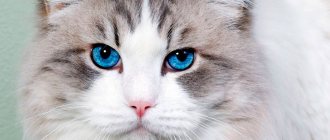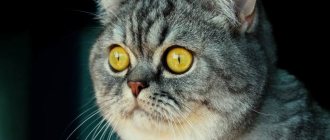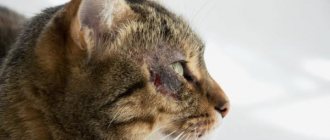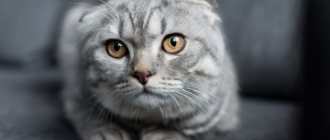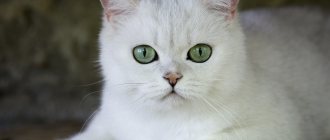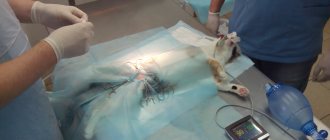Some cat breeds, due to the peculiarities of their anatomical structure, require regular care for their visual organs - their eyes.
In addition, any cat has physiological conditions or health deviations when eye care measures are required during the treatment process.
How to properly carry out care procedures, what products to use, and what do certain deviations in the condition of the eyes indicate?
What is necessary for daily cat eye care?
Some cat breeds (those with flat faces and long hair, such as Persian cats) require regular eye washes.
To do this, you can use furatsilin or special drops that are sold in veterinary pharmacies and pet stores. The eyes are washed twice a day according to the following scheme:
- 1-2 drops of the drug are instilled into each eye.
- The cat's eyelids are gently massaged.
- The drug is removed using a clean cotton pad.
There are lotions for everyday eye care, as well as lotions for removing tear tracks.
Prevention of eye diseases in cats
Prevention of eye diseases consists of the following actions:
- do not smoke in the room where the pet lives, avoid using perfumes and household chemicals;
- use hypoallergenic ready-made comas of at least premium class;
- destroy ectoparasites and conduct quarterly deworming;
- Vaccinate your pet regularly according to the vaccination plan.
- cats predisposed to eye diseases are periodically instilled with prophylactic agents.
Be sure to read:
A cat sniffles through its nose: reasons, what to do when it is normal, sniffling is a sign of disease
Eye diseases or digestive disorders are caused by human food, so giving your pet a treat can result in illness.
Two troubles
In cats with a flattened face (Persians), the nasolacrimal duct is curved. Therefore, cats of this breed have increased lacrimation. Moisture evaporates around the eyes and brown crusts form. Irritation can occur in the folds of the nose, leading to dermatitis.
A cat's tears contain substances that, when interacting with air, oxidize and give the tear first a mucous consistency and then a reddish tint. Moreover, tear stains are not visible on the fur of calico cats. On cats with light and black fur, the spots are noticeable. Prolonged lacrimation causes severe dermatitis.
Sources
- David, Ramey Navicular syndrome in horses / Ramey David. - M.: Aquarium, 2008. - 215 p.
- Smirnova, L.M. Obstetrics and gynecology / L.M. Smirnova, R.A. Saidova, S.G. Braginskaya. - M.: Medicine, 2020. - 368 p.
- Gavrish, V. G. Treatment of domestic animals and birds for farmers and amateur livestock breeders: monograph. / V.G. Gavrish, I.I. Kalyuzhny. - Moscow: Russian State University for the Humanities, 1999. - 480 p.
- Konopatov, Yu. V. Biochemistry of animals. Textbook / Yu.V. Konopatov, S.V. Vasilyeva. - M.: Lan, 2020. - 384 p.
How to examine your eyes
Preventative examination of each eye should be carried out 1-2 times a month. Bring your cat to a window or an area with good lighting. It's better not to shine a flashlight in your pet's eyes - he won't like it. If the cat does not want to lie quietly on its back, wrap it in a towel.
Healthy eyes of a cat are clean and clear with the same size pupils, the whites of the eyes are always white. The third eyelid should not be visible. When examining, carefully move your pet's eyelid and look at the mucous membrane: healthy membranes are pale pink.
The kitten must be accustomed to this procedure from childhood: this way he will understand that they do not want to offend him and will not fight with you.
Treatment
Fortunately, modern veterinary medicine has a huge selection of remedies that can eradicate almost any disease, especially if the owners sounded the alarm in time and began treatment.
The cat has an inflamed eye: how to treat it at home
In addition to antiseptic ointments and drops, you can use folk remedies, for example, a solution of potassium permanganate.
You can drop levomycin, gentaimycin, or other drops into your eyes. Albucid burns, so it will be difficult to use: the mustachioed patient will try to escape at the first opportunity. Solcoseryl, if placed under the eyelid, will help the wound heal faster. Erythro- and neomycin ointments are also excellent for treatment.
Just in case, in parallel with the course of antibiotics, it is recommended to take anti-allergenic drugs. They can be purchased in the form of tablets or injections, depending on which form is more convenient.
Important! When choosing a form of medication, you need to think about how to give it. It is very difficult for a strong and ferocious cat to force a pill into its mouth, even if it has already been caught and held in its hands. It will be a little easier to prick her, because you won’t have to unclench your tightly clenched jaws. In the case of a soft and flexible kitty, you can take tablets.
How to wash your pet's eyes?
Before rinsing, you need to prepare the necessary tools and eye care products in advance. In addition to the solution, you will need gauze pads, cotton wool or cotton pads. Try to fix the animal in one position. A cat or small dog can be placed in a carrier so that only the animal's head appears from the carrier. It is best to sit a large dog on your lap.
We invite you to familiarize yourself with Laparoscopic sterilization of cats: preparation, implementation and care
Before the procedure, you need to wash your hands thoroughly with soap. It is better to start the actual rinsing by treating the skin around the eye and eyelids. If a crust has already formed there, then moisten it for several minutes using cotton wool or gauze. When the crust has softened enough, wipe it off with a dry cotton pad.
After treating the eyelid, you can begin to actually wash the eye. This procedure can be performed in several ways:
Do not forget to remove the needle from the syringe; it is most convenient to use a disposable 20 ml syringe. Carefully fix the pet's head and spread the eyelids using your fingers. Carefully aim the stream at the upper part of the eye, located closer to the nose, in which case the product will wet its entire surface and also enter the conjunctival sac.
Chemistry against panic
In cases where a pet has encountered chemicals, it is important to find out what exactly it was stained with. And then choose what to wash the kitten’s eyes with:
- Before rinsing your eye, make sure that the solution you choose does not react violently with the chemical agent;
IMPORTANT! Trying to immediately neutralize a substance is dangerous. The reaction can be violent and can further damage vision. For a short time after the chemical gets into the eye, it will be contained by the mucous membrane.
- First, rinse your eyes with water; A warm (about 35 degrees) shower or water fountain for rinsing should be “soft”;
- After washing, it will be necessary to neutralize the remaining aggressive substance. Let someone help you save time while you prepare the neutralizing solution.
- It takes 10-15 minutes to rinse the cat's eyes from chemicals with clean running water. The eyelids should be wide open (you will have to help the animal, even if it resists).
ADVICE! Almost all synthetic cleaners and detergents are slightly acidic, while natural soaps are alkaline.
Acids
After a water shower, continue to rinse with a 2% sodium bicarbonate solution (can be purchased at a pharmacy). If the pain bothers your pet too much, instilling a drop of novocaine solution (1%, for the eyes) is acceptable.
Alkalis
Alkali is quite difficult to remove from the mucous membrane. After a ten-minute rinse with water, at least half an hour of neutralization with isotonic sodium chloride (saline solution for injection) will be required. And then a 1% aqueous solution of ascorbic acid will not be amiss.
What dangerous symptoms can be identified?
Sometimes, when examining a cat's eyes, you may find the following signs of a problem:
- one or both eyes closed when the cat is awake;
- swollen eyelids;
- redness of the mucous membranes, cornea;
- changes in corneal pigmentation;
- wounds on the eyelids or directly on the eyeball;
- cloudiness on the surface or inside the eye;
- discharge of pus, blood, mucus;
- the third eyelid is noticeable all the time;
- sinking or, conversely, widening of one or both eyes;
- nystagmus (the so-called trembling of the pupils);
- dirty marks around the eyes - brown, green, white or the like.
If you have one or more of these symptoms, you should definitely visit a veterinary clinic. Eye diseases can also be accompanied by a general deterioration in the pet’s well-being.
Do your pet's eyes need our help?
Some naturally healthy and adaptable animals do not require eye care throughout their lives. Others cannot last even a day without the help of their owner.
This can only be determined in relation to the conditions in which your dog or cat is currently kept. When moving to another place of residence, the condition of the eyes (if it is not an infection) can change significantly without human intervention.
We invite you to familiarize yourself with the Cornish Rex: a curly-haired cat with a canine character
Signs of eye problems are often visible to the naked eye. The main thing is to pay attention to them in time:
- Dry crusts quickly accumulate in the inner corner of the eye and have to be removed by rinsing or simply using your finger.
- The eyelids are swollen and “stuck together.”
- Excessive tear production is observed, and moist “tracks” form under the eyes.
- The discharge from the eyes is thick, it dries on the eyelashes or is visible on the surface of the cornea in the form of translucent clots.
If you notice any of the above in your pet, then he cannot do without your help.
Please note that all further recommendations are given for animals that have normal body temperature, are active, have a good appetite and normal level of thirst, preserved stool and urination, and in general - for those that are clinically healthy.
If your pet’s condition gives you any concern, contact your veterinarian immediately, because discharge from the eyes can be only one of the symptoms of an infectious or other serious disease.
Types of pathological discharge
It's worse when the cat's eyes run brown or the discharge is bloody. Such cases are no longer so clearly harmless. The dark or brownish color of the discharge is due to the pigment produced when an infection occurs. If pus is released at the same time, the animal definitely needs treatment. Otherwise, you can carefully remove the brown secretion with a damp cloth and observe the situation. If the secretion no longer leaks, everything is fine. Systematic discharge or something red around the eyes is a reason to consult a veterinarian.
Discharge from a pregnant cat: bloody, yellow
The factors that cause ocular drainage are very varied. Not all of them are equally dangerous, but it is better to be safe than not to notice the manifestations of a serious disease.
Causes of discharge not related to infection:
- mechanical damage to the eyes or head;
- something got into the eye;
- allergic reactions;
- various pathologies of the lacrimal canal;
- impaired eyelash growth that irritates the eyes;
- neoplasms that interfere with the functioning of the lacrimal canal;
Possible infections:
- viral;
- conjunctivitis;
- inflammation of the eyelids, cornea or eyeball;
- malfunction of the eye vessels;
Important! Dark secretions can also be a result of glaucoma. It develops as a complication from surgery, after prolonged inflammation, or as an independent disease. The sooner it is detected, the better, so constant discharge should not be ignored.
Exudate is something that is released from blood or lymphatic vessels onto the surface of the body or in its cavity due to increased pressure or disruption of tissue integrity. It comes in different types.
Purulent
The main feature is a large number of leukocyte cells. It can be brown, yellow or white, sometimes even bluish, dirty gray or green.
It often leaks from the corner of the eye
Fibrinous
It contains a high concentration of fibrin, a blood protein responsible for drying wounds. Upon contact with damaged areas, it thickens and forms a crust. When the crust falls off, an ulcer remains in its place, which then heals. Fibrinous exudate is usually caused by toxins or viruses.
Serous
Almost transparent, it dissolves easily and leaves no traces. Formed during burns, allergies or viral inflammation.
Hemorrhagic
It has a pink or even reddish tint. It sometimes appears with allergic inflammation, and malignant tumors can also cause its appearance.
Important! Any exudate can turn into this bloody type, so it can only be considered a separate variety only conditionally.
Putrefactive
This type is characterized by the presence of anaerobic rotting bacteria in the secretions. It smells bad of indole or skatole (everyone knows the smell of rotten food in everyday life) and is colored dirty green. Putrid exudate is also not an independent species; its origin can be of any kind. It indicates that the tissues are undergoing decomposition, and the situation is quite advanced.
Cholesterol
A thick yellow-brown substance, sometimes acquiring a brownish tint, is obtained from secretions of another type if they stagnate in the cavity for a long time, losing excess water and minerals.
Neutrophilic
At the very beginning of suppuration, neutrophil appears from the serous exudate. When it becomes purulent, neutrophil cells are destroyed. This occurs in later stages of the disease.
Exudation itself is part of the process of combating pathogenic microorganisms. Along with the fluid, cells enter the tissue that neutralize the infection, and metabolic processes in this area slow down to prevent the spread of microbes to other areas of the body. However, accumulations of exudate inside can cause pain, and with a large amount of, for example, purulent exudate, they can cause an abscess with subsequent rupture.
General rules of care from 3 months to a year
In the future, there are no longer any special nuances of caring for cat eyes, but we would like to provide a list of useful rules that it is advisable to follow:
- You should always monitor the cleanliness of your cat's eyes; if necessary, any discharge that appears or debris that has entered the conjunctival cavity is removed by washing it with warm saline.
- You should not use cotton wool to wipe your eyes, as its fibers caught in the conjunctival cavity can stimulate the development of the inflammatory process.
- It is strongly not recommended to clean your eyes with plain water (even filtered, boiled and sterile), since its use disrupts the natural pH of the conjunctival cavity.
- In addition, we do not recommend using decoctions of chamomile and other herbs for eye care, as they too often cause the development of allergic reactions.
- You should not use any medical or veterinary products to care for your animal’s eyes without first consulting a specialist.
If the veterinarian has prescribed any medications to care for the kitten’s eyes, treatment should be continued until an “official” decision to discontinue it. Otherwise, the animal can be “healed” to the point of blindness. The eyes are too important and vulnerable an organ, so there is no need to risk its health!
Physiological reasons
The main physiological reason for the formation of dark secretion even from one eye is stenosis (narrowing) of the lacrimal openings. This is a congenital or acquired pathology.
There is a small chance that a kitten will be born with narrowed tear ducts. As soon as signs of disease appear, the animal is taken to the veterinarian.
If necessary, surgery is performed using a probe to widen the tear ducts.
Acquired stenosis manifests itself after suffering inflammatory diseases. Due to the pathological process, the lacrimal canal narrows.
Treatment is carried out under the supervision of a veterinarian. Antibacterial therapy is used, followed by surgery.
How to wash eyes for dogs and cats
It is advisable to wash your pet’s eyes from 1 time a day (at night) to 3 times a day (for example, after each walk), generously moistening a cotton pad with the liquid of your choice and moving it along the eyelid towards the inner corner of the eye. Possible directions are from the outer corner of the eye to the inner, around the eyes, from the center to the periphery.
Read the label carefully and remember that “for washing the eyes” and “for caring for the hair around the eyes” are not the same thing!
When washing your eyes, try to use solutions and lotions at room temperature, or better yet, at body temperature. Cold solutions can cause discomfort in your pet and problems with his eyes in the future.
Strictly observe the expiration dates of lotions and solutions - there is no need for extra germs in your eyes!
We invite you to familiarize yourself with dilated pupils in a cat
If washing within 3-5 days does not cause a significant improvement in the condition of the eyes and a reduction in discharge, be sure to consult a veterinarian.
If the advice of a general practitioner does not help within a week, do not wait for the “sea weather” and contact a veterinary ophthalmologist!
Healthy and shining eyes to your pets!
Natalya Troshina, veterinarian (DVM)
Three stages of eye treatment
Stage one: applying cleansers.
The area around the eyes is usually wiped with lotion, moistening a cotton pad until the dirt is completely removed. A tampon is needed for each eye. Medicines that need to be instilled are administered using a pipette.
Stage two: you need to carefully dry the cleaned wool, blotting it with a soft cloth. For Persians, dry all the folds on the nose.
Apply a protective gel to the dried hair of the lower eyelid using a cotton swab. And until it dries, you need to comb it with a brush.
Caring for your cat's eyes is very important, don't forget.
Eye care for cats and dogs
Eye washing is a common preventive measure, as well as a way to prevent damage to the eyes if harmful substances, such as deodorant or foreign objects (dust, debris, etc.) get into them. The most striking symptom of foreign objects or substances getting on the surface of the eyeball is copious mucus secretion.
However, the eyes of pets can leak for many reasons, for example, due to such a dangerous disease as distemper. Rinsing the eyes will help if the cause of the mucus discharge was fairly harmless. Therefore, in the event of a precedent, it is advisable to show the dog or cat to a veterinarian. The procedure may also be necessary before using certain medications.
Causes
In normal condition, the animal's eyeball is constantly moistened with tear fluid. It protects it from infections and foreign bodies.
In a healthy cat, waste fluid enters the nasal canal and evaporates. If it begins to accumulate, darkens, and acquires an unpleasant odor, this indicates an infection of the eyes and inflammation of the tear ducts.
Dacryocystitis
With this pathology, there is a violation of the outflow of tear fluid through the excretory canal.
Reasons due to which this problem occurs:
- inflammatory process;
- chronic conjunctivitis;
- entry of a foreign body into the lacrimal canal;
- injuries to the eye, eyelids, head;
- oncological neoplasms;
- allergy;
- everted eyelid.
As soon as the cause of dacryocystitis is established, the veterinarian prescribes treatment in each specific case.
The inflammatory process is controlled with the help of medications. In all other cases, surgical intervention is required. In cases of cancer, the pet undergoes chemotherapy.
Inflammation of the tear duct due to infections
Blockage of the duct can occur due to conjunctivitis, iridocyclitis, keratitis, blepharitis. These are infectious diseases, mechanical injuries to the eyes that cause damage to the eyelids, ciliary bulbs, cornea, and iris.
Antibacterial therapy is used for all types of lesions. In some cases, antiviral and antifungal drugs are used. If the disease is advanced, ointments based on hormones are used.
